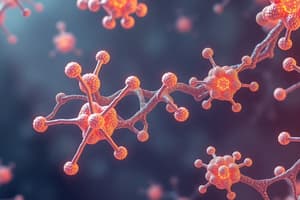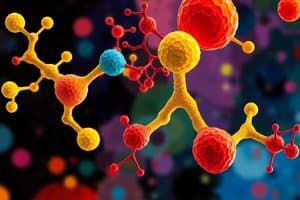Podcast
Questions and Answers
Match the organ systems with their main functions and key structures:
Match the organ systems with their main functions and key structures:
Skeletal system = Support, protection, and movement Muscular system = Movement and stabilization Nervous system = Collect, process, and respond to sensory info Endocrine system = Production and secretion of hormones for regulation Cardiovascular system = Gas exchange and nutrient transport Respiratory system = Gas exchange Digestive system = Break down food and absorb nutrients Urinary system = Water balance, waste elimination, blood filter and volume regulator Integumentary system = Protection, temperature and water regulation Immune system = Protection Lymphatic system = Filtering and protecting Reproductive system = Reproduce and nurture developing offspring
What describes the dorsal body cavity?
What describes the dorsal body cavity?
Entire cavity encased in bony structures for protection of the fragile nervous system organs.
What describes the ventral body cavity?
What describes the ventral body cavity?
A less protected cavity to allow more mobility.
What is a cell?
What is a cell?
What is an organelle?
What is an organelle?
What are macromolecules?
What are macromolecules?
What is a nucleotide?
What is a nucleotide?
What is a fatty acid?
What is a fatty acid?
What is a monosaccharide?
What is a monosaccharide?
What is an amino acid?
What is an amino acid?
Enzymes are biological catalysts that enhance the rate of biochemical reactions by increasing the activation energy required.
Enzymes are biological catalysts that enhance the rate of biochemical reactions by increasing the activation energy required.
What role does the cell membrane play?
What role does the cell membrane play?
Which of the following molecules can pass easily through the cell membrane?
Which of the following molecules can pass easily through the cell membrane?
Which organelle is responsible for the site of cellular respiration?
Which organelle is responsible for the site of cellular respiration?
What does homeostasis refer to?
What does homeostasis refer to?
Passive transport requires extra energy to move molecules across the cell membrane.
Passive transport requires extra energy to move molecules across the cell membrane.
What are the main types of cellular transport?
What are the main types of cellular transport?
Define feedback inhibition.
Define feedback inhibition.
What is differentiation in biology?
What is differentiation in biology?
Flashcards are hidden until you start studying
Study Notes
Cell Biology Vocabulary
- Cell: Basic unit of life; smallest part of an organism capable of life processes.
- Organelle: Specialized cell structures that perform specific functions.
- Macromolecule: Large biological molecules essential for life.
- Nucleotide: Building block of nucleic acids (DNA/RNA).
- Fatty Acid: Building block of lipids.
- Monosaccharide: Building block of carbohydrates.
- Amino Acid: Building block of proteins.
- Enzyme: Protein catalysts that speed up biochemical reactions.
- Catalyst: Substance that lowers activation energy and accelerates reactions.
- Active Site: Specific region on an enzyme where substrates bind.
- Differentiation: Process where stem cells develop into specialized cells.
Characteristics of Living Things
- All living organisms are made of cells.
- They respond to their environment and stimuli.
- Capable of growth and reproduction.
- Utilize energy and have metabolism.
- Contain DNA or RNA as genetic material.
- Adapt to their surroundings.
Role of Cell Organelles
- Cell Membrane: Regulates entry and exit of substances.
- Centrioles: Assist in cell division and anchor spindle fibers.
- Cilia: Propel fluid over cell surfaces.
- Flagella: Enable movement of the cell.
- Nucleus: Houses DNA; controls cellular activities.
- Ribosomes: Synthesize proteins.
- Rough ER: Manufactures proteins.
- Smooth ER: Synthesizes lipids and modifies chemicals.
- Golgi Apparatus: Processes and ships proteins.
- Vesicles: Transport proteins within or outside the cell.
- Lysosomes: Decompose materials.
- Vacuoles: Store substances.
- Mitochondria: Sites for cellular respiration.
Cell Membrane Structure
- Comprised of two layers of phospholipids with hydrophilic heads and hydrophobic tails.
- Embedded carbohydrates enhance structure and communication.
- Proteins serve as channels for transport and signaling.
- Selective Permeability: Small, nonpolar, neutrals, and water pass easily; polar and large molecules require assistance.
Importance of Macromolecules
- Carbohydrates: Energy storage and structural roles in signaling.
- Lipids: Energy storage, cell membrane formation, insulation, and protection.
- Nucleic Acids: Genetic information storage and transmission.
- Proteins: Perform varied functions including regulation, signaling, and transport.
DNA, Chromosomes, and Genes
- DNA holds genetic information organized into chromosomes (46 in humans).
- Chromosomes consist of thousands of genes that guide protein synthesis.
- Proteins are essential for bodily processes.
Enzyme Function
- Enzymes act as biological catalysts, increasing the rate of chemical reactions.
- Highly specific for their substrates; essential for biochemical regulation.
Levels of Organization
- Organizational hierarchy: Organism → Organ systems → Organs → Tissues → Cells.
Cell Cycle Overview
- Interphase: Majority of cell life; includes S phase for DNA replication.
- Mitosis: Division phases: Prophase, Metaphase, Anaphase, Telophase.
- Cytokinesis: Splitting of cytoplasm into two identical cells.
Form Dictates Function
- Structure of cells and organs dictates their functions, impacting physiological processes.
Homeostasis Vocabulary
- Homeostasis: Maintenance of stable internal conditions.
- Receptor: Sensory organ that detects stimuli.
- Stimulus: Trigger for a response.
- Effector: Organ that executes the response.
- Response: Outcome induced by a stimulus.
- Feedback Inhibition: Output of a system influences its own regulation.
Types of Transport
- Passive Transport: Movement without energy, down concentration gradient.
- Active Transport: Energy-requiring movement against concentration gradient.
- Hypertonic, Hypotonic, Isotonic Solutions: Relate to water concentration differences relative to cell cytoplasm.
Cell Signaling
- Signal Transduction Pathway: Sequence of events leading to a cellular response.
- Inhibitors: Molecules blocking normal ligand binding.
- Phosphorylation and Dephosphorylation: Modification processes affecting signaling and response.
Body Planes and Anatomical Terms
- Anatomy: Study of structures; includes axial (head and trunk) and appendicular (limbs) regions.
- Dorsal vs. Ventral Cavities: Dorsal provides protection for nervous structures; ventral allows mobility.
Organ Systems Overview
- Skeletal System: Support and movement; consists of bones and connective tissues.
- Muscular System: Movement and stability; includes three muscle types.
- Nervous System: Processes sensory information; includes brain and nerves.
- Endocrine System: Hormonal regulation through glands.
- Cardiovascular System: Circulates blood and nutrients.
- Respiratory System: Facilitates gas exchange.
- Digestive System: Nutrient absorption.
- Urinary System: Waste elimination and blood filtering.
- Immune System: Body protection mechanisms.
- Lymphatic System: Filters and protects the body.
- Reproductive System: Offspring development support.
Studying That Suits You
Use AI to generate personalized quizzes and flashcards to suit your learning preferences.



